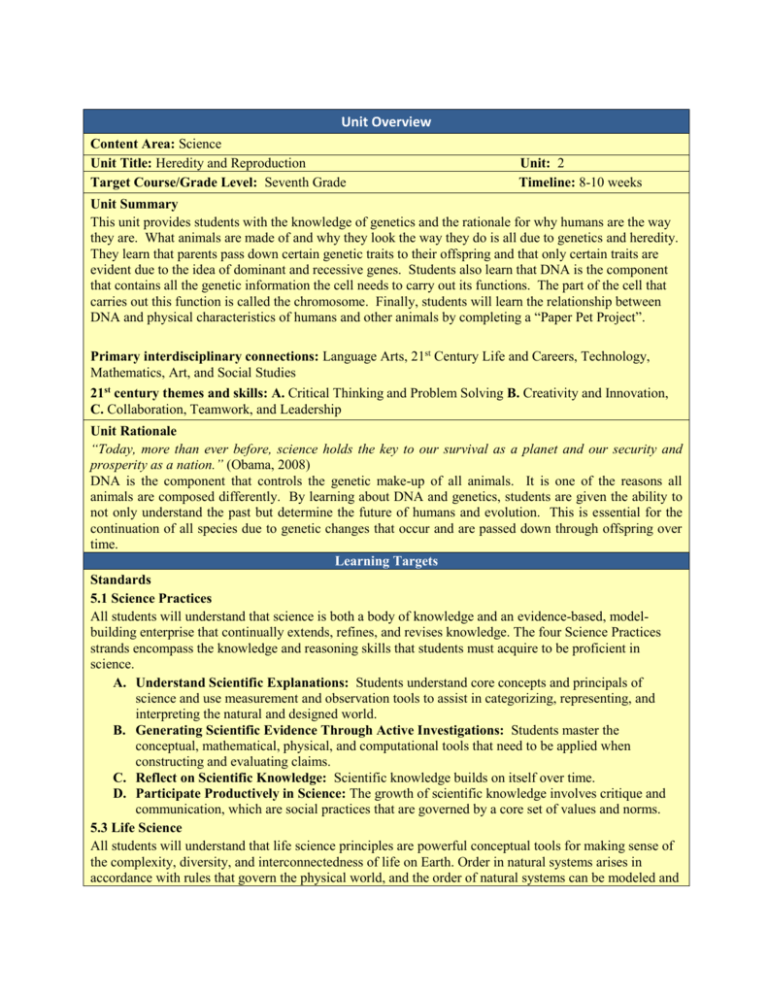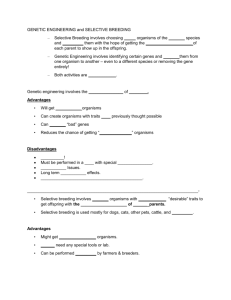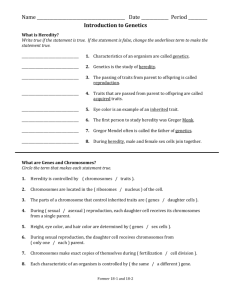Unit 2 - Heredity Reproduction
advertisement

Unit Overview Content Area: Science Unit Title: Heredity and Reproduction Target Course/Grade Level: Seventh Grade Unit: 2 Timeline: 8-10 weeks Unit Summary This unit provides students with the knowledge of genetics and the rationale for why humans are the way they are. What animals are made of and why they look the way they do is all due to genetics and heredity. They learn that parents pass down certain genetic traits to their offspring and that only certain traits are evident due to the idea of dominant and recessive genes. Students also learn that DNA is the component that contains all the genetic information the cell needs to carry out its functions. The part of the cell that carries out this function is called the chromosome. Finally, students will learn the relationship between DNA and physical characteristics of humans and other animals by completing a “Paper Pet Project”. Primary interdisciplinary connections: Language Arts, 21st Century Life and Careers, Technology, Mathematics, Art, and Social Studies 21st century themes and skills: A. Critical Thinking and Problem Solving B. Creativity and Innovation, C. Collaboration, Teamwork, and Leadership Unit Rationale “Today, more than ever before, science holds the key to our survival as a planet and our security and prosperity as a nation.” (Obama, 2008) DNA is the component that controls the genetic make-up of all animals. It is one of the reasons all animals are composed differently. By learning about DNA and genetics, students are given the ability to not only understand the past but determine the future of humans and evolution. This is essential for the continuation of all species due to genetic changes that occur and are passed down through offspring over time. Learning Targets Standards 5.1 Science Practices All students will understand that science is both a body of knowledge and an evidence-based, modelbuilding enterprise that continually extends, refines, and revises knowledge. The four Science Practices strands encompass the knowledge and reasoning skills that students must acquire to be proficient in science. A. Understand Scientific Explanations: Students understand core concepts and principals of science and use measurement and observation tools to assist in categorizing, representing, and interpreting the natural and designed world. B. Generating Scientific Evidence Through Active Investigations: Students master the conceptual, mathematical, physical, and computational tools that need to be applied when constructing and evaluating claims. C. Reflect on Scientific Knowledge: Scientific knowledge builds on itself over time. D. Participate Productively in Science: The growth of scientific knowledge involves critique and communication, which are social practices that are governed by a core set of values and norms. 5.3 Life Science All students will understand that life science principles are powerful conceptual tools for making sense of the complexity, diversity, and interconnectedness of life on Earth. Order in natural systems arises in accordance with rules that govern the physical world, and the order of natural systems can be modeled and predicted through the use of mathematics. A. Heredity and Reproduction: Organisms reproduce, develop, and have predictable life cycles. Organisms contain genetic information that influences their traits, and they pass this on to their offspring during reproduction. Standard 9.1 21st-Century Life & Career Skills All students will demonstrate the creative, critical thinking, collaboration, and problem-solving skills needed to function successfully as both global citizens and workers in diverse ethnic and organizational cultures. Content Statements: Related Content Statements for Standard 5.1 Core scientific concepts and principles represent the conceptual basis for model-building and facilitate the generation of new and productive questions. Predictions and explanations are revised based on systematic observations, accurate measurements, and structured data/evidence. Evidence is generated and evaluated as part of building and refining models and explanations. Scientific models and understandings of fundamental concepts and principles are refined as new evidence is considered. Science involves practicing productive social interactions with peers, such as partner talk, wholegroup discussions, and small-group work. In order to determine which arguments and explanations are most persuasive, communities of learners work collaboratively to pose, refine, and evaluate questions, investigations, models, and theories (e.g., argumentation, representation, visualization, etc.). Instruments of measurement can be used to safely gather accurate information for making scientific comparisons of objects and events. Related Content Statements for Standard 5.3 Reproduction is essential to the continuation of every species. Variations exist among organisms of the same generation (e.g., siblings) and of different generations (e.g., parent to offspring). Traits such as eye color in human beings or fruit/flower color in plants are inherited. Some organisms reproduce asexually. In these organisms, all genetic information comes from a single parent. Some organisms reproduce sexually, through which half of the genetic information comes from each parent. The unique combination of genetic material from each parent in sexually reproducing organisms results in the potential for variation. Characteristics of organisms are influenced by heredity and/or their environment. Related Content Statement for Standard 9.1 The ability to recognize a problem and apply critical thinking and problem-solving skills to solve the problem is a lifelong skill that develops over time. Gathering and evaluating knowledge and information from a variety of sources, including global perspectives, fosters creativity and innovative thinking. Collaboration and teamwork enable individuals or groups to achieve common goals with greater efficiency. Leadership abilities develop over time through participation in groups and/or teams that are engaged in challenging or competitive activities. CPI # Cumulative Progress Indicator (CPI) 5.1.8.A.1 Demonstrate understanding and use interrelationships among central scientific concepts to revise explanations and to consider alternative explanations. 5.1.8.A.3 Use scientific principles and models to frame and synthesize scientific arguments and pose theories. 5.1.8.B.1 Design investigations and use scientific instrumentation to collect, analyze, and evaluate evidence as part of building and revising models and explanations. 5.1.8.C.1 Monitor one’s own thinking as understandings of scientific concepts are refined. 5.1.8.D.1 Engage in multiple forms of discussion in order to process, make sense of, and learn from others’ ideas, observations, and experiences. 5.1.8.D.2 Engage in productive scientific discussion practices during conversations with peers, both face-to-face and virtually, in the context of scientific investigations and model-building. 5.1.8.D.3 Demonstrate how to safely use tools, instruments, and supplies. 5.3.6.D.1 Predict the long-term effect of interference with normal patterns of reproduction. 5.3.6.D.2 Explain how knowledge of inherited variations within and between generations is applied to farming and animal breeding. 5.3.6.D.3 Distinguish between inherited and acquired traits/characteristics. 5.3.8.D.1 Defend the principle that, through reproduction, genetic traits are passed from one generation to the next, using evidence collected from observations of inherited traits. 5.3.8.D.2 Explain the source of variation among siblings. 5.3.8.D.3 Describe the environmental conditions or factors that may lead to a change in a cell’s genetic information or to an organism’s development, and how these changes are passed on. 9.1.8.A.1 Develop strategies to reinforce positive attitudes and productive behaviors that impact critical thinking and problem-solving skills. 9.1.8.B.1 Use multiple points of view to create alternative solutions. 9.1.8.C.1 Determine an individual’s responsibility for personal actions and contributions to group activities. 9.1.8.C.2 Demonstrate the use of compromise, consensus, and community building strategies for carrying out different tasks, assignments, and projects. 9.1.8.C.3 Model leadership skills during classroom and extra-curricular activities. Unit Enduring Understandings Unit Essential Questions How are traits passed from parents to offspring? Due to Gregor Mendel’s discovery of genes and alleles it was found that an organisms traits are What controls the inheritance of traits in controlled by the alleles it inherited from its organisms? parents. Some alleles may be recessive while What is probability and how does it help explain others are dominant. Dominant alleles are a trait the results of genetic crosses? that always shows up when the allele is present. What role do chromosomes play in inheritance? On the other hand, a recessive allele, is hidden What is the relationship between genes and the whenever a dominant allele is present. environment? Probability is a number that describes how likely it How do we build and refine models that describe is that an event will occur; however the predicted and explain the natural and designed world? event my not necessarily take place. The use of Punnett Squares aid in showing all the possibly What constitutes useful scientific evidence? combinations of alleles that result from a genetic cross. In a genetic cross, the allele that each parent will pass on to its offspring is based on probability. Within each chromosome is an organisms DNA (DNA holds all the information a cell needs to carry out its functions), chromosomes are important in the inheritance of traits. One chromosome in the pair came from the female parent while the other chromosome came from the male parent. Walter Sutton, an American geneticist, studied the movement of chromosomes in grasshoppers. Using this information he came up with the chromosome theory of inheritance. The theory states that genes are carried from parents to their offspring on chromosomes. Chromosomes are made up of genes; human body cells have 23 pairs or 46 chromosomes. Each body cell can contain between 20,000 and 25,000 genes, and each gene controls a trait. The effects of genes are regularly influenced by the environment. Diet, lacking in protein, minerals, or vitamins can affect the height of an individual no matter what information is in their genes. Genes and the environment interact to determine a person’s characteristics. Measurement and observation tools are used to categorize, represent and interpret the natural world. Evidence is used for building, refining, and/or critiquing scientific explanations. Unit Learning Targets Students will ... Describe the results of Mendel’s experiments. Identify what controls the inheritance of traits in organisms. Utilize probability and describe how it helps explain the results of genetic crosses. Compare and contract genotype vs. phenotype. Explain what co-dominance is. Explain who Walter Sutton is and what his contributions to science are. Describe the role chromosomes play in inheritance. Identify the events that occur during meiosis. Explain the relationship between genes and chromosomes. Explain what forms the genetic code. Describe how a cell produces protein. Identify how mutations can affect an organism. Identify some patterns of inheritance in humans. Describe the functions of sex chromosomes. Explain the relationship between genes and the environment. State the goal of the Human Genome Project. Evidence of Learning Summative Assessment After learning about the basis of genetics and its function in heredity students will create a “Paper Pet Project”; this will help the students to explore how traits are passed from parent to offspring. The pet will be crossed with another classmates pet and the students will determine what traits the offspring will have. All “Paper Pet Projects” need to be unique and have five different traits. The projects will include one pet crossing with another pet, production of six offspring, in conclusion students determining what traits the offspring will have and explain how those traits came to be. A rubric will be used to assess neatness, creativity, accuracy in identifying phenotypes and genotypes (of pet and offspring), effectiveness of students design, display, and class presentation. Equipment needed: construction paper, drawing utensils, glue, tape, poster board, optional: glitter, beads, feathers, sequins, stickers, yarn, buttons Teacher Instructional Resources: Discovery Education, Science Explorer: Life Science Textbook, library books, Internet: various websites, All-In-One Teaching Resources Workbooks Formative Assessments Life Science Guided Reading and Study Worksheets Mendel’s Experiment: crossing of Pea Plants Mendel’s Work Quiz Punnett Square Formation and Utilization of Family Traits Probability and Heredity Quiz Meiosis Poster Creation Genetic Code (messenger RNA) Dominant vs. Recessive (using flies) Unit Test: Genetics: The Science of Heredity Integration of Technology: Students will use Microsoft Office programs, the SMARTBoard and ELMO for project construction and presentations. They will also use various websites to help engineer their research projects. Technology Resources: Click the links below to access additional resources used to design this unit: Discovery Education: http://www.discoveryeducation.com/ National Geographic: http://www.nationalgeographic.com/ Opportunities for Differentiation: This unit caters to students of all learning styles (i.e., kinesthetic, visual, tactile and auditory instruction). The students work individually, in partners, and within groups. The groups are composed of those that are at a variety of learning levels. Groups change consistently throughout the unit. Students will also work in pairs and individually during different activities in the unit. The students are given the opportunity to use skills such as inference while conducting labs and reading comprehension to answer questions in the text and on worksheets. They will also conduct hands-on labs and projects to aid in the further understanding of certain scientific concepts being taught. Teacher Notes: If computer or Internet access is not available to students they can use non-fictional texts to perform research for the summative assessment. For the “Paper Pet Project”, students will be allowed the option to choose their own pet traits or the teacher can assign the traits to guarantee various experimental results.









